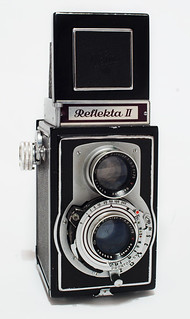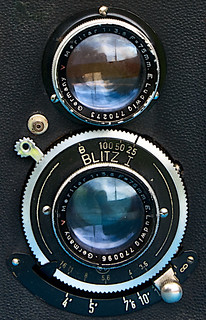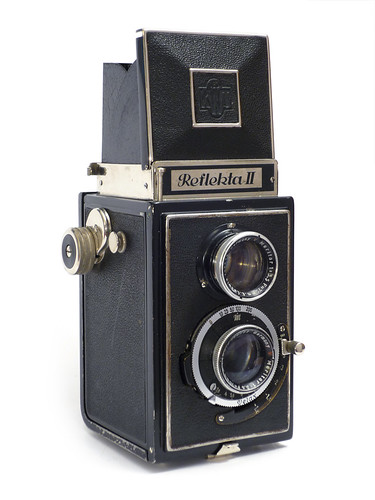Difference between revisions of "Reflekta"
Hanskerensky (talk | contribs) m (Image farm5.static.flickr.com/4120/4861322797_013bde3a43.jpg, corrected source URL) |
Hanskerensky (talk | contribs) (Started with a more detailed description, STILL UNDER CONSTRUCTION) |
||
| Line 12: | Line 12: | ||
The Reflekta was replaced by the [[Weltaflex]] in the mid-1950s. | The Reflekta was replaced by the [[Weltaflex]] in the mid-1950s. | ||
| + | |||
| + | |||
| + | == Reflekta and Reflekta I == | ||
| + | Focusing is done by a lever under the taking lens. The framecounter is a small red window on the back of the camera. | ||
| + | * Format : 12 images size 6 x 6 cm on [[120]] type [[rollfilm]] | ||
| + | * Known Lens/Shutter combinations : <br/> | ||
| + | <!--Novar 4.5/105 mm lens in a [[Prontor-S]] shutter <br/> | ||
| + | Novar 3.5/105 mm lens in a [[Prontor-S]] shutter <br/> | ||
| + | Tessar 3.5/105 mm lens in a [[Synchro-Compur]] shutter | ||
| + | * Filter Size : ? | ||
| + | * Flash synchronisation : Socket on shutter, X-synchronisation | ||
| + | * Selftimer : Yes | ||
| + | * Lighmeter system : none | ||
| + | * Double exposure prevention : No | ||
| + | * Color Finish : Black with chrome topcover and ornaments --> | ||
| + | * Color Leatherette : Black | ||
| + | * Dimensions WxHxD (folded) : ?x?x? mm | ||
| + | * Weight: ??? grams | ||
| + | |||
| + | |||
| + | Four 75/3.5 lenses are reported: the Triotar and Trioplan by [[Meyer]], the Meritar by [[Ludwig]] and the Pololyt by [[ROW]]. Similarly, four different shutters are known on this camera; Cludor (B, 1–1/200s), Junior and Vebur (B, 1–1/250s), Prontor-SV (B, 1–1/300s). It uses 120 film. | ||
| + | |||
== Description and specs of the Reflekta II == | == Description and specs of the Reflekta II == | ||
| − | Focusing is done by a lever under the taking lens. The framecounter is a small red window on the back of the camera | + | Focusing is done by a lever under the taking lens. The framecounter is a small red window on the back of the camera. |
Four 75/3.5 lenses are reported: the Triotar and Trioplan by [[Meyer]], the Meritar by [[Ludwig]] and the Pololyt by [[ROW]]. Similarly, four different shutters are known on this camera; Cludor (B, 1–1/200s), Junior and Vebur (B, 1–1/250s), Prontor-SV (B, 1–1/300s). It uses 120 film. | Four 75/3.5 lenses are reported: the Triotar and Trioplan by [[Meyer]], the Meritar by [[Ludwig]] and the Pololyt by [[ROW]]. Similarly, four different shutters are known on this camera; Cludor (B, 1–1/200s), Junior and Vebur (B, 1–1/250s), Prontor-SV (B, 1–1/300s). It uses 120 film. | ||
Revision as of 19:35, 28 November 2015
| |||
| German TLR () | |||
|---|---|---|---|
| 35 mm | Contaflex | Flexilette | Optima Reflex | ||
| 3×4 | Pilot Reflex | ||
| 4×4 | Baby Rolleiflex (1931) | Baby Rolleiflex (1957) | Karma-Flex | ||
| 6×6 | Altiflex | Amplion Reflex | Brillant | Flektar | Flexo | Flexora | Flexora II | Flexora III | Foth-Flex | Ikoflex 1 | Ikoflex II | Ikoflex Ia | Ikoflex Ic Ikoflex Favorit | Karma-Flex | Mentorett | Montiflex | Peerflekta | Perfekta | Photina Reflex | Plascaflex | Reflecta | Reflekta | Reflekta II | Rica Flex | Rocca Automatic | Rocca Super Reflex | Rolleiflex | Rolleicord | Rollop | Superb | Superflex | Trumpfreflex | Vitaflex | Weltaflex | Wirgin Reflex | Zeca-Flex | ||
| 6×9 | Superfekta | ||
The Reflekta is a continuation of the Reflecta by Kamera-Werk Tharandt. The model name was spelled with a "k" from 1949 onwards. The Reflekta II is a version with double exposure prevention.
The production of the Reflekta and Reflekta II was taken over in 1950 by VEB Welta-Kamera-Werk, a merger of Welta and Kamera-Werk Tharandt.
The Reflekta was replaced by the Weltaflex in the mid-1950s.
Contents
Reflekta and Reflekta I
Focusing is done by a lever under the taking lens. The framecounter is a small red window on the back of the camera.
- Format : 12 images size 6 x 6 cm on 120 type rollfilm
- Known Lens/Shutter combinations :
- Color Leatherette : Black
- Dimensions WxHxD (folded) : ?x?x? mm
- Weight: ??? grams
Four 75/3.5 lenses are reported: the Triotar and Trioplan by Meyer, the Meritar by Ludwig and the Pololyt by ROW. Similarly, four different shutters are known on this camera; Cludor (B, 1–1/200s), Junior and Vebur (B, 1–1/250s), Prontor-SV (B, 1–1/300s). It uses 120 film.
Description and specs of the Reflekta II
Focusing is done by a lever under the taking lens. The framecounter is a small red window on the back of the camera.
Four 75/3.5 lenses are reported: the Triotar and Trioplan by Meyer, the Meritar by Ludwig and the Pololyt by ROW. Similarly, four different shutters are known on this camera; Cludor (B, 1–1/200s), Junior and Vebur (B, 1–1/250s), Prontor-SV (B, 1–1/300s). It uses 120 film.
Name variants
The Flektar is an export version sold by Peerless.[1] The Superflex is another export version sold by Penn.[2]
Pictures

|
| Welta Reflekta II (1950-1955) Pololyt 3.5/75 in Prontor-SV shutter image by Tomasz Zdankowski (Image rights) |

|
| lens twins image by Dirk HR Spennemann (Image rights) |

|
| VEB KW Tharandt Reflekta II (1949-1950) Meritar 3.5/75 in Velax shutter Note the KWT logo on the finder cover. image by Danipuntocom (Image rights) |

|
| Welta Reflekta (1950-1951) Pololyt 3.5/75 in Blitz I shutter image by Andrys Stienstra (Image rights) |
Notes
Bibliography
- McKeown, James M. and Joan C. McKeown's Price Guide to Antique and Classic Cameras, 12th Edition, 2005-2006. USA, Centennial Photo Service, 2004. ISBN 0-931838-40-1 (hardcover). ISBN 0-931838-41-X (softcover). Pp. 823–4, 984 and 993–4.
Links
In English:
- Reflekta II at The Camera Site
- VEB KW Tharandt Reflekta II at Daniel Jiménez's From the focal plane to infinity
- Richter and Welta TLR cameras at Barry Toogood's www.tlr-cameras.com
In German:
- Welta Reflekta II in Erik Fiss' photo website
- Welta Reflekta II at Tom Kurpjuweits' photo website
- Pages of Frank Gähler www.reflekta.de with Reflekta, Reflecta, Vitaflex, Trumpfreflex, Reflekta I, Reflekta II, Peerflekta II, Peerflekta V, Flektar, Wirgin TLR, in all Variations
In Polish:
- Reflekta II (Pololyt, Prontor-SV) at blog.zdankowski.com
